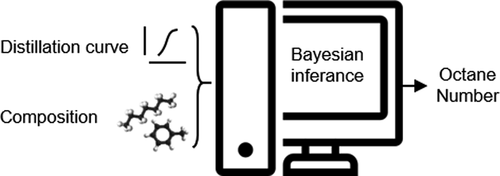当前位置:
X-MOL 学术
›
Energy Fuels
›
论文详情
Our official English website, www.x-mol.net, welcomes your
feedback! (Note: you will need to create a separate account there.)
Prediction of the Octane Number: A Bayesian Pseudo-Component Method
Energy & Fuels ( IF 5.2 ) Pub Date : 2020-09-03 , DOI: 10.1021/acs.energyfuels.0c01700 S. Tipler 1, 2, 3 , M. Fürst 1, 3, 4 , Q. Van Haute 5 , F. Contino 2, 3 , A. Coussement 1, 3
Energy & Fuels ( IF 5.2 ) Pub Date : 2020-09-03 , DOI: 10.1021/acs.energyfuels.0c01700 S. Tipler 1, 2, 3 , M. Fürst 1, 3, 4 , Q. Van Haute 5 , F. Contino 2, 3 , A. Coussement 1, 3
Affiliation

|
Energy transition leads to the development of unconventional liquid fuels. Unconventional liquid fuels are produced at a small scale; so, they are produced with a limited budget, and they must be characterized at a cheap price. When liquid fuels are burned in piston engines, they are characterized by the research octane number (RON) and the motor octane number (MON). As the measurement of the RON and the MON is expensive, a cheaper alternative, like the pseudo-component method, is sought. Nevertheless, this method was only developed for the RON, it is not applicable for complex fuels with olefins and oxygenates, and its uncertainty has not been characterized. Moreover, it does not differentiate the isomers. For instance, the iso-paraffins are considered as a blend of 2-methyl-alkane, 3-methyl-alkane, 2,2-dimethyl-alkane, and 2,3-dimethyl-alkane in equal proportions. The authors address the limitations of the pseudo-component method using a Bayesian approach. The validity of the method is demonstrated for three gasoline blendstocks mixed with five oxygenated molecules: 1-propanol, 2-propanol, 1-butanol, 2-butanol, and 2-methyl-1-propanol. As a result, the octane numbers are predicted within the theoretical uncertainty bounds and with less than 2% error.
中文翻译:

辛烷值的预测:贝叶斯伪分量方法
能源过渡导致非常规液体燃料的发展。非常规液体燃料的生产规模很小。因此,它们的生产预算有限,而且必须以低廉的价格进行表征。当液体燃料在活塞发动机中燃烧时,它们的特征是研究辛烷值(RON)和电动机辛烷值(MON)。由于RON和MON的测量很昂贵,因此寻求一种更便宜的替代方法,例如伪分量法。然而,该方法仅针对RON开发,不适用于含烯烃和含氧化合物的复杂燃料,其不确定性尚未得到表征。而且,它不区分异构体。例如,异链烷烃被认为是2-甲基-烷烃,3-甲基-烷烃,2,2-二甲基-烷烃和2的混合物 等比例的3-二甲基烷烃。作者使用贝叶斯方法解决了伪分量方法的局限性。证明了该方法对三种汽油混合原料与五个氧化分子混合的有效性:1-丙醇,2-丙醇,1-丁醇,2-丁醇和2-甲基-1-丙醇。结果,预测辛烷值在理论不确定性范围内,并且误差小于2%。
更新日期:2020-10-16
中文翻译:

辛烷值的预测:贝叶斯伪分量方法
能源过渡导致非常规液体燃料的发展。非常规液体燃料的生产规模很小。因此,它们的生产预算有限,而且必须以低廉的价格进行表征。当液体燃料在活塞发动机中燃烧时,它们的特征是研究辛烷值(RON)和电动机辛烷值(MON)。由于RON和MON的测量很昂贵,因此寻求一种更便宜的替代方法,例如伪分量法。然而,该方法仅针对RON开发,不适用于含烯烃和含氧化合物的复杂燃料,其不确定性尚未得到表征。而且,它不区分异构体。例如,异链烷烃被认为是2-甲基-烷烃,3-甲基-烷烃,2,2-二甲基-烷烃和2的混合物 等比例的3-二甲基烷烃。作者使用贝叶斯方法解决了伪分量方法的局限性。证明了该方法对三种汽油混合原料与五个氧化分子混合的有效性:1-丙醇,2-丙醇,1-丁醇,2-丁醇和2-甲基-1-丙醇。结果,预测辛烷值在理论不确定性范围内,并且误差小于2%。











































 京公网安备 11010802027423号
京公网安备 11010802027423号